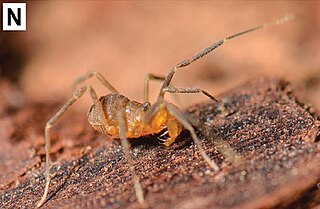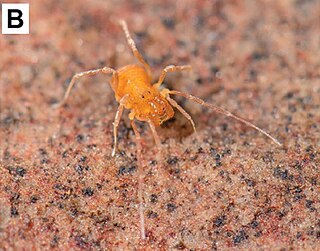
The Phalangodidae are a family of harvestmen with about 30 genera and more than 100 described species, distributed in the Holarctic region.

Ischyropsalididae is a family of harvestmen with 31 described species in 3 genera, found in Europe and North America.
Kimulidae is a small neotropical family of the harvestman infraorder Grassatores with about thirty described species.
The Travuniidae are a small family of harvestman with little more than ten described species, within the suborder Laniatores.

Theromaster is a genus of armoured harvestmen in the family Cladonychiidae. There are at least two described species in Theromaster, found in the eastern United States.
Travunioidea is a superfamily of armoured harvestmen in the order Opiliones. There are 4 families and more than 70 described species in Travunioidea.

Texella is a genus of armoured harvestmen in the family Phalangodidae. There are more than 20 described species in Texella.

Zuma is a genus of harvestman in the family Paranonychidae. There are at least two described species in Zuma, found in central and northern California.

Isolachus is a genus of armoured harvestmen in the family Cladonychiidae. There is one described species in Isolachus, I. spinosus, found in Oregon and Washington.

Paranonychus is a genus of harvestman in the family Paranonychidae. There are at least three described species in Paranonychus.
Megacina is a genus of armoured harvestmen in the family Phalangodidae. There are at least four described species in Megacina.

Erebomaster is a genus of armoured harvestmen in the family Travuniidae. There are at least three described species in Erebomaster.

Calicina is a genus of armoured harvestmen in the family Phalangodidae. There are more than 20 described species in Calicina.

Briggsus is a genus of armoured harvestmen in the family Cladonychiidae. There are about five described species in Briggsus, found in the coastal forests of Oregon and Washington.
Buemarinoa is a genus of armoured harvestmen in the family Cladonychiidae. There is one described species in Buemarinoa, B. patrizii, found in Sardinia, Italy.

Holoscotolemon is a genus of armoured harvestmen in the family Cladonychiidae. There are about eight described species in Holoscotolemon, found in Europe.
Metanonychus is a genus of harvestman in the family Paranonychidae. There are at least three described species in Metanonychus, found in the northwestern United States.

Peltonychia is a genus of armoured harvestmen in the family Cladonychiidae. There are about nine described species in Peltonychia, found in Europe.
Speleomaster is a genus of armoured harvestmen in the family Cryptomastridae. There are at least two described species in Speleomaster, both found in lava tubes of the Snake River Plain in southern Idaho.
Travunia is a genus of harvestman in the family Travuniidae. There are about five described species in Travunia. They are found in caves in the southern Dinaric Karst region of Balkan Europe.












